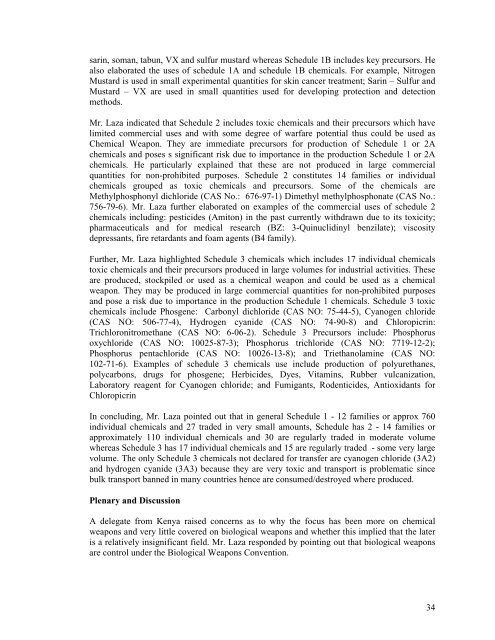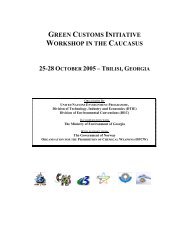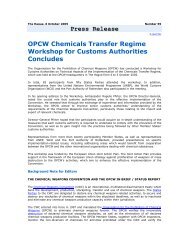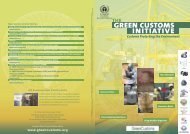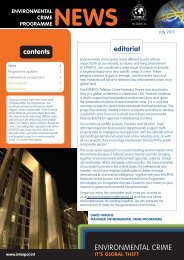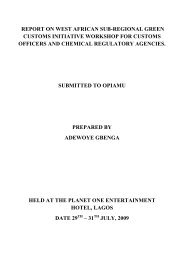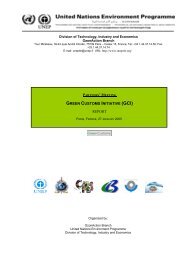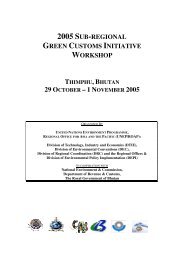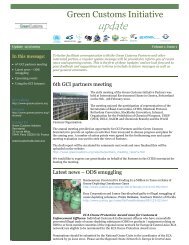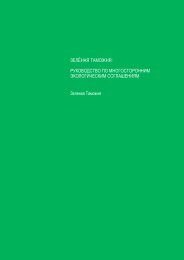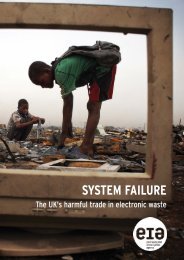Arusha - Green Customs Initiative
Arusha - Green Customs Initiative
Arusha - Green Customs Initiative
You also want an ePaper? Increase the reach of your titles
YUMPU automatically turns print PDFs into web optimized ePapers that Google loves.
sarin, soman, tabun, VX and sulfur mustard whereas Schedule 1B includes key precursors. He<br />
also elaborated the uses of schedule 1A and schedule 1B chemicals. For example, Nitrogen<br />
Mustard is used in small experimental quantities for skin cancer treatment; Sarin – Sulfur and<br />
Mustard – VX are used in small quantities used for developing protection and detection<br />
methods.<br />
Mr. Laza indicated that Schedule 2 includes toxic chemicals and their precursors which have<br />
limited commercial uses and with some degree of warfare potential thus could be used as<br />
Chemical Weapon. They are immediate precursors for production of Schedule 1 or 2A<br />
chemicals and poses s significant risk due to importance in the production Schedule 1 or 2A<br />
chemicals. He particularly explained that these are not produced in large commercial<br />
quantities for non-prohibited purposes. Schedule 2 constitutes 14 families or individual<br />
chemicals grouped as toxic chemicals and precursors. Some of the chemicals are<br />
Methylphosphonyl dichloride (CAS No.: 676-97-1) Dimethyl methylphosphonate (CAS No.:<br />
756-79-6). Mr. Laza further elaborated on examples of the commercial uses of schedule 2<br />
chemicals including: pesticides (Amiton) in the past currently withdrawn due to its toxicity;<br />
pharmaceuticals and for medical research (BZ: 3-Quinuclidinyl benzilate); viscosity<br />
depressants, fire retardants and foam agents (B4 family).<br />
Further, Mr. Laza highlighted Schedule 3 chemicals which includes 17 individual chemicals<br />
toxic chemicals and their precursors produced in large volumes for industrial activities. These<br />
are produced, stockpiled or used as a chemical weapon and could be used as a chemical<br />
weapon. They may be produced in large commercial quantities for non-prohibited purposes<br />
and pose a risk due to importance in the production Schedule 1 chemicals. Schedule 3 toxic<br />
chemicals include Phosgene: Carbonyl dichloride (CAS NO: 75-44-5), Cyanogen chloride<br />
(CAS NO: 506-77-4), Hydrogen cyanide (CAS NO: 74-90-8) and Chloropicrin:<br />
Trichloronitromethane (CAS NO: 6-06-2). Schedule 3 Precursors include: Phosphorus<br />
oxychloride (CAS NO: 10025-87-3); Phosphorus trichloride (CAS NO: 7719-12-2);<br />
Phosphorus pentachloride (CAS NO: 10026-13-8); and Triethanolamine (CAS NO:<br />
102-71-6). Examples of schedule 3 chemicals use include production of polyurethanes,<br />
polycarbons, drugs for phosgene; Herbicides, Dyes, Vitamins, Rubber vulcanization,<br />
Laboratory reagent for Cyanogen chloride; and Fumigants, Rodenticides, Antioxidants for<br />
Chloropicrin<br />
In concluding, Mr. Laza pointed out that in general Schedule 1 - 12 families or approx 760<br />
individual chemicals and 27 traded in very small amounts, Schedule has 2 - 14 families or<br />
approximately 110 individual chemicals and 30 are regularly traded in moderate volume<br />
whereas Schedule 3 has 17 individual chemicals and 15 are regularly traded - some very large<br />
volume. The only Schedule 3 chemicals not declared for transfer are cyanogen chloride (3A2)<br />
and hydrogen cyanide (3A3) because they are very toxic and transport is problematic since<br />
bulk transport banned in many countries hence are consumed/destroyed where produced.<br />
Plenary and Discussion<br />
A delegate from Kenya raised concerns as to why the focus has been more on chemical<br />
weapons and very little covered on biological weapons and whether this implied that the later<br />
is a relatively insignificant field. Mr. Laza responded by pointing out that biological weapons<br />
are control under the Biological Weapons Convention.<br />
34


